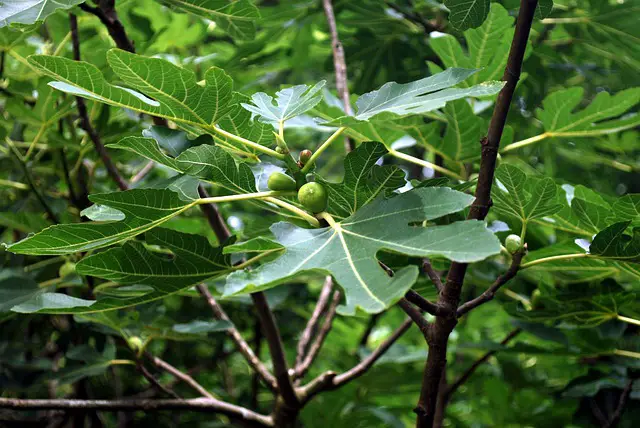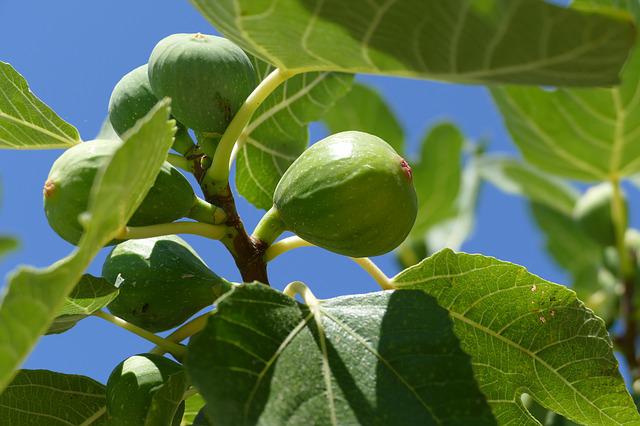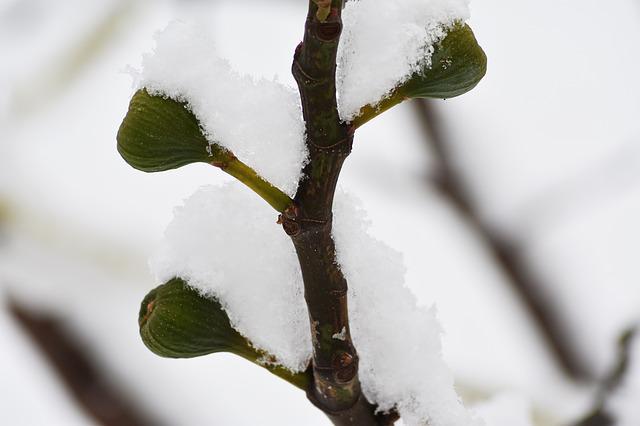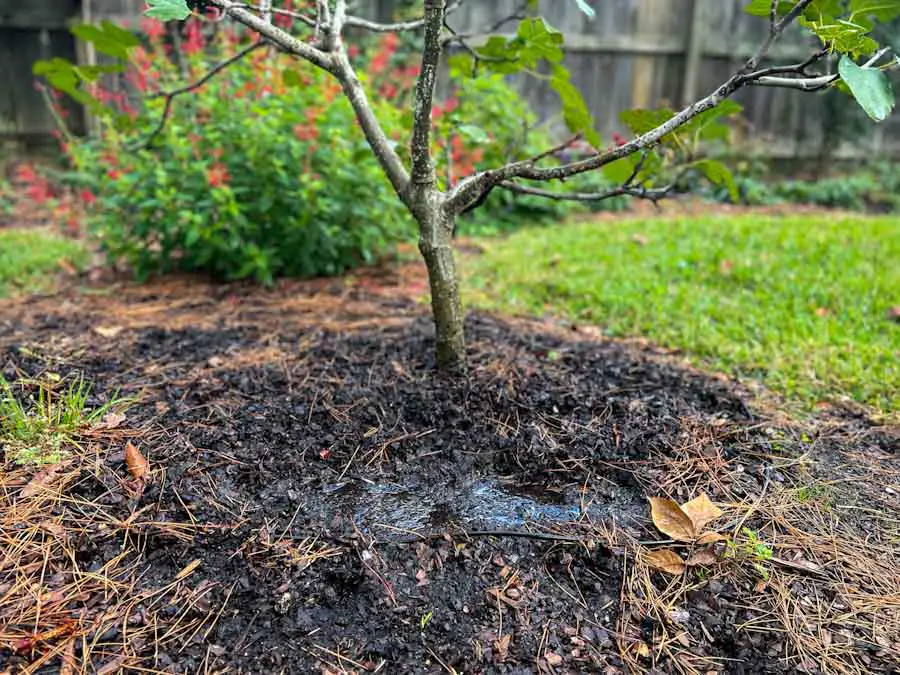Before you can reap the benefits of growing your own figs, the first step is to plant the tree in an ideal location. Continue reading for a primer on how to choose the perfect spot for your fig tree.

We may receive commissions from purchases made through links in this post, at no additional cost to you.
When I decided to plant a fig tree in my backyard, I already knew exactly where I’d put it. But just as I was about to dig the first shovelful of dirt, I paused. Had I chosen the right location for my fig tree? What else should I have considered before committing to the perfect spot?
Just like any living thing, fig trees thrive when you take into account all of their basic needs. (For example, my basic needs include chocolate and a good book.) Light, soil, water, and space are just a few things to consider when choosing your fig tree’s long-term home.
Fig trees need to be planted in a location with at least 6-8 hours of full sun, protection from wind and cold, and with well-draining and slightly acidic soil. If conditions in your garden are not ideal, or if you are in a colder growing zone, consider growing your fig tree in a large container. Whatever you choose, homegrown figs are worth the hassle of finding the right spot.
How much space does a fig tree need?
The fig tree you bought from the garden center may look compact in its gallon-size pot, but pay close attention to the plant tag – specifically the maximum size information. Give your new fig tree plenty of room to grow to its full mature size.

Some fig tree varieties (such as ‘Black Mission‘) can grow as tall as 30 feet or more. But the smallest fig varieties (like ‘Little Miss Figgy’) may only reach 4 feet tall.
Learn more: If space is an issue, see this post for a list of compact fig varieties: 14 Fantastic Figs for Growing in Containers.
If you plan to plant more than one fig tree, space them 10-25 feet apart (depending on which varieties you plant). As a rule of thumb, find out the mature width of the tree, then leave that much space between trees. So two 10-foot wide fig trees should be planted at least 10 feet apart. Fig trees love lots of room, and your tree will fruit better with plenty of growing space.
You can prune a fig tree to stay smaller, or you can even train it into a shrub or bush. However, any fig tree planted directly into the ground will have a fairly extensive, although shallow, root system. Fig tree roots can be invasive and cause damage to nearby structures, so place your trees at least 10-15 feet away from sidewalks, driveways, or your home. It is best to grow fig trees on the outskirts of your garden or surrounded by plenty of open space.
Sunlight

Fig trees need at least 6-8 hours of direct sunlight to prosper, as do most fruit trees. Ideally, plant your fig tree in a southern-facing area of your garden that gets bright sunlight for most of the day. Full sunlight is essential to keep your fig trees happy and to grow the sweetest fruit possible.
Protection from the Elements
Fig trees originate from the Mediterranean region and therefore generally prefer mild climates. However, some cold-tolerant varieties such as ‘Chicago Hardy‘ can survive temperatures as low as -20° F (USDA zone 5). In colder climates, try planting your fig tree near a light-colored fence or wall (at least 10-15 feet away). The warm sunlight will reflect off of the surface, trapping warm air and creating a slightly milder microclimate.
Established fig trees are more cold-hardy than young trees. In a very hard freeze a tree may lose limbs or branches, or even appear to die completely, but the rootstock can survive to produce new growth in the spring.
Your best bet is to choose a cold-hardy variety that is suited to your growing zone. Even so, young or newly planted trees can benefit from some additional cold-weather protection, such as mulching or wrapping in burlap.

Protecting your fig tree from extreme wind is also essential, especially for newly planted trees without a developed root system. Your yard may already provide some shelter from the wind in certain areas, such as near large trees or a perimeter fence. A small hill, or even your house, can serve as a natural windbreak, protecting your fig tree from strong winds.

Curious about any garden-related terms? Click on a highlighted word in the text, or visit The Fruit Grove Glossary to find out more.
What Kind of Soil Does a Fig Tree Need?
Ideally, plant your fig tree in an area with well-draining, sandy loam soil. There are things you can do, however, to improve less-than-perfect soil. If you have very heavy clay soil, then dig in lots of organic material (such as compost or well-rotted manure) around the planting area. Fig trees can tolerate some clay in the soil, but if it’s too heavy the area won’t drain well, potentially causing the roots to rot.
Learn more: Soil Drainage for Fruit Trees: Everything You Need to Know
Fig trees can grow happily in a variety of soil conditions. They are fairly drought-tolerant once established. You may not even need to provide additional irrigation for most of the growing season, depending on rainfall. During the first couple of years of growth, keep the soil evenly moist to encourage the root system to develop and spread. Figs don’t like having “wet feet,” so avoid any areas that remain soggy for a long time.

Fig trees are pretty forgiving when it comes to the pH of the soil they grow in. The best range for figs is a pH between 6.0 and 6.5 (slightly acidic soil), but they will tolerate soil that is close to neutral, with a pH anywhere between 6.0 and 8.0.
They don’t love very alkaline soil, however. If your soil is too alkaline, you can add a soil acidifier (granular sulfur) to adjust the pH. If your pH is low (too acidic), add garden lime to increase alkalinity. Dig in the additives through the entire planting area, following package instructions, about 6 feet across and at least 8 inches deep.
Learn more: Soil pH for Fruit Trees: Why It Matters and How to Adjust It
Grow Figs in a Container
Finally, if you’ve searched around your yard and just can’t find that sweet spot to plant a fig tree, try planting in a container. Fig trees grow very well in large pots and can still provide a good fruit harvest if cared for properly. They are also very attractive trees, with interesting forms and large, decorative leaves, so they can make a great addition to a patio or deck.
Check out the video below, where I show how to pot a fig tree step by step:
Related: The Best Potting Soil for Fig Trees (Plus How to Make It)
Another advantage to growing a fig tree in a pot is that it will keep the size in check. Even large varieties, such as ‘Brown Turkey‘, will be more compact if the root system has to stay contained.
Just about any fig tree can be pruned to grow in a container, as long as you’ve chosen the right-sized pot. Pick a pot that’s just a bit bigger than the pot the tree came in from the nursery. As the tree grows, you can re-pot to a larger container.
Learn more: How to Grow Figs in Containers: A Complete Guide
In colder climates, it’s easy to move a potted fig tree to protect it from frost damage. Store your potted fig in an unheated garage or basement over the winter. Keep it in a sheltered, but still cold, location to encourage dormancy. Don’t water your dormant fig tree too often over the winter (maybe once a month), or you increase the risk of root rot.
Bring the fig tree back outside as soon as the nights are consistently above around 25 or 30 degrees (depending on how cold-tolerant your fig tree is). If new leaves have already started to grow by this point, wait until all chance of frost has passed before bringing it out.
Still not sure whether to plant your fig tree in the ground or in a pot? Check out this article: Potted vs. In-Ground Fig Trees: Which is Better?

